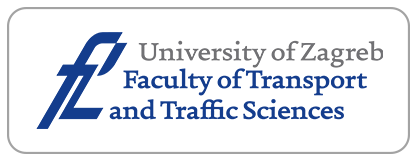Riding the Edge – Unveiling the Key Factors behind Injury Severity in Single-Vehicle Motorcycle Crashes

Downloads
Motorcyclists are among the most vulnerable road users, with single-vehicle crashes often resulting in severe or fatal injuries. Although some earlier studies focus on motorcyclists, crash statistics show significant space for motorcyclist safety improvement. This study examines the factors influencing crash severity by analysing police-reported crash data in the Republic of Croatia from 2017 to 2022, incorporating rider characteristics, roadway and environmental conditions, and crash circumstances. A data-driven approach was applied to assess the relative importance of these factors in determining single-vehicle motorcycle crash injury severity. This study utilised two different modelling approaches – multinomial logistic regression and random forest modelling to investigate the factors influencing crash severity. The results highlight that rider age, road type, speed conditions and alcohol consumption significantly influence crash outcomes. Older riders and crashes occurring on county and local roads were more likely to result in severe or fatal injuries. At the same time, inappropriate speed and collisions with roadside objects further increased the likelihood of fatal outcomes. The findings suggest the necessity of targeted interventions, including enhanced speed management, infrastructure improvements, stricter enforcement of alcohol regulations and advanced rider safety programs. To complement this research, future research should integrate more detailed behavioural and vehicle-specific data to refine injury severity predictions. This study provides valuable insights for policymakers and transportation safety professionals seeking to mitigate the severity of motorcycle crashes and enhance overall road safety.
Downloads
World Health Organization. Road Traffic Injuries. https://www.who.int/news-room/fact-sheets/detail/road-traffic-injuries [Accessed 11th Apr. 2023].
Elliot MA, et al. Motorcycle safety: A scoping study. TRL Report TRL581. 2003.
Petit L, et al. A review of common motorcycle collision mechanisms of injury. EFORT Open Reviews. 2020;5(9):544-548. DOI: 10.1302/2058-5241.5.190090.
Road Safety Thematic Report – Motorcycles. European Road Safety Observatory. Brussels, European Commission, Directorate General for Transport. Brussels, Belgium; 2023.
Bulletin on Road Traffic Safety in 2023. Ministry of the Interior of the Republic of Croatia. Zagreb, Croatia; 2024.
Facts and Figures – Motorcyclists and Moped Riders – 2021. Brussels, Belgium; 2021. https://road-safety.transport.ec.europa.eu/system/files/2022-03/FF_powered_twowheelers_20220209.pdf [Accessed 16th May 2023].
Pervez A, Lee J, Huang H, Zhai X. What factors would make single-vehicle motorcycle crashes fatal? Empirical evidence from Pakistan. International Journal of Environmental Research and Public Health. 2022;19(10):5813. DOI: 10.3390/ijerph19105813.
Lin HY, et al. Environmental factors associated with severe motorcycle crash injury in university neighborhoods: A multicenter study in Taiwan. International Journal of Environmental Research and Public Health. 2022;19(16). DOI: 10.3390/ijerph191610274.
Afshar F, Seyedabrishami S, Moridpour S. Application of extremely randomised trees for exploring influential factors on variant crash severity data. Scientific Reports. 2022;12(1):11476. DOI: 10.1038/s41598-022-15693-7.
Aarts LT, et al. Study on serious road traffic injuries in the EU. Brussels, Belgium.
Tollazzi T, Parežnik LB, Gruden C, Renčelj M. In-depth analysis of fatal motorcycle accidents—Case study in Slovenia. Sustainability. 2025;17(3):876. DOI: 10.3390/su17030876.
Savolainen P, Mannering F. Probabilistic models of motorcyclists’ injury severities in single- and multi-vehicle crashes. Accident Analysis & Prevention. 2007;39(5):955-963. DOI: 10.1016/j.aap.2006.12.016.
Wang MH. Investigating the difference in factors contributing to the likelihood of motorcyclist fatalities in single motorcycle and multiple vehicle crashes. International Journal of Environmental Research and Public Health. 2022;19(14):8411. DOI: 10.3390/ijerph19148411.
Santos K, Firme B, Dias JP, Amado C. Analysis of motorcycle accident injury severity and performance comparison of machine learning algorithms. Transportation Research Record: Journal of the Transportation Research Board. 2024;2678(1):736-748. DOI: 10.1177/03611981231172507.
Seyfi MA, Aghabayk K, Karimi Mamaghan AM, Shiwakoti N. Modeling the motorcycle crash severity on nonintersection urban roadways in the Australian state of Victoria using a random parameters logit model. Journal of Advanced Transportation. 2023;2023:1-12. DOI: 10.1155/2023/2250590.
Farid A, Ksaibati K. Modeling severities of motorcycle crashes using random parameters. Journal of Traffic and Transportation Engineering (English Edition). 2021;8(2):225-236. DOI: 10.1016/j.jtte.2020.01.001.
Wei F, et al. Investigating rural single-vehicle crash severity by vehicle types using full Bayesian spatial random parameters logit model. Applied Sciences. 2021;11(17):7819. DOI: 10.3390/app11177819.
Sivasankaran SK, Rangam H, Balasubramanian V. Investigation of factors contributing to injury severity in single vehicle motorcycle crashes in India. International Journal of Injury Control and Safety Promotion. 2021;28(2):243-254. DOI: 10.1080/17457300.2021.1908367.
Zulherman D, Yang J, Shimizu K, Yokota Y. Deep Q-learning network-based imbalanced classification for fatality prediction of single-vehicle motorcycle crashes. International Journal of Intelligent Transportation Systems Research. 2024. DOI: 10.1007/s13177-024-00440-1.
Zulherman D, Yang J, Yokota Y. Examining the factors affecting single-vehicle motorcycle crashes using association rules mining: Case study of Japan. In: 2022 IEEE 25th International Conference on Intelligent Transportation Systems (ITSC). IEEE; 2022. p. 1222-1227. DOI: 10.1109/ITSC55140.2022.9922376.
Shaheed MS, Gkritza K. A latent class analysis of single-vehicle motorcycle crash severity outcomes. Analytical Methods in Accident Research. 2014;2:30-38. DOI: 10.1016/j.amar.2014.03.002.
Quddus MA, Noland RB, Chin HC. An analysis of motorcycle injury and vehicle damage severity using ordered probit models. 2002. www.elsevier.com/locate/jsr.
Das S, et al. Using deep learning in severity analysis of at-fault motorcycle rider crashes. Transportation Research Record: Journal of the Transportation Research Board. 2018;2672(34):122-134. DOI: 10.1177/0361198118797212.
Cheng W, et al. Predicting motorcycle crash injury severity using weather data and alternative Bayesian multivariate crash frequency models. Accident Analysis & Prevention. 2017;108:172-180. DOI: 10.1016/j.aap.2017.08.032.
Pai CW, Saleh W. Modelling motorcyclist injury severity by various crash types at T-junctions in the UK. Safety Science. 2008;46(8):1234-1247. DOI: 10.1016/j.ssci.2007.07.005.
Waseem M, Ahmed A, Saeed TU. Factors affecting motorcyclists’ injury severities: An empirical assessment using random parameters logit model with heterogeneity in means and variances. Accident Analysis & Prevention. 2019;123:12-19. DOI: 10.1016/j.aap.2018.10.022.
Wisutwattanasak P, et al. Factors Affecting Single and Multivehicle Motorcycle Crashes: Insights from Day and Night Analysis Using XGBoost-SHAP Algorithm. Big Data and Cognitive Computing. 2024;8(10):128. DOI: 10.3390/bdcc8100128.
Anarkooli AJ, Hosseinpour M, Kardar A. Investigation of factors affecting the injury severity of single-vehicle rollover crashes: A random-effects generalized ordered probit model. Accident Analysis & Prevention. 2017;106:399-410. DOI: 10.1016/j.aap.2017.07.008.
Abdulhafedh A. Road crash prediction models: Different statistical modeling approaches. Journal of Transportation Technologies. 2017;7(2):190-205. DOI: 10.4236/jtts.2017.72014.
Rezapour M, Mehrara Molan A, Ksaibati K. Analyzing injury severity of motorcycle at-fault crashes using machine learning techniques, decision tree and logistic regression models. International Journal of Transportation Science and Technology. 2020;9(2):89-99. DOI: 10.1016/j.ijtst.2019.10.002.
Rezapour M, Farid A, Nazneen S, Ksaibati K. Using machine learning techniques for evaluation of motorcycle injury severity. IATSS Research. 2021;45(3):277-285. DOI: 10.1016/j.iatssr.2020.07.004.
Upton GJG. Multinomial logistic regression. In: Categorical Data Analysis by Example. Wiley; 2016. p. 109-124. DOI: 10.1002/9781119450382.ch10.
El-Habil AM. An application on multinomial logistic regression model. Pakistan Journal of Statistics and Operation Research. 2012;8(2):271. DOI: 10.18187/pjsor.v8i2.234.
Abdillah A, et al. Application of multinomial logistic regression to analyze learning difficulties in statistics courses. Journal of Physics: Conference Series. 2020;1490(1):012012. DOI: 10.1088/1742-6596/1490/1/012012.
Breiman L. Random forests. Machine Learning. 2001;45(1):5-32. DOI: 10.1023/A:1010933404324.
Sarker IH, Salah K. AppsPred: Predicting context-aware smartphone apps using random forest learning. Internet of Things. 2019;8:100106. DOI: 10.1016/j.iot.2019.100106.
Liu CY, Ku CY, Wu TY, Ku YC. An advanced soil classification method employing the random forest technique in machine learning. Applied Sciences. 2024;14(16):7202. DOI: 10.3390/app14167202.
Dutta P, Paul S, Kumar A. Comparative analysis of various supervised machine learning techniques for diagnosis of COVID-19. In: Electronic Devices, Circuits, and Systems for Biomedical Applications. Elsevier; 2021. p. 521-540. DOI: 10.1016/B978-0-323-85172-5.00020-4.
Louppe G, Wehenkel L, Sutera A, Geurts P. Understanding variable importances in forests of randomized trees. In: Proceedings of the 27th International Conference on Neural Information Processing Systems (NIPS'13). Curran Associates Inc.; 2013.
Sikdar S, Hooker G, Kadiyali V. Variable importance measures for multivariate random forests. Journal of Data Science. 2025;243-263. DOI: 10.6339/24-JDS1152.
Nembrini S, König IR, Wright MN. The revival of the Gini importance? Bioinformatics. 2018;34(21):3711-3718. DOI: 10.1093/bioinformatics/bty373.
Melo F. Area under the ROC Curve. In: Encyclopedia of Systems Biology. Springer; 2013. p. 38-39. DOI: 10.1007/978-1-4419-9863-7_209.
Pai CW, Saleh W. An analysis of motorcyclist injury severity under various traffic control measures at three-legged junctions in the UK. Safety Science. 2007;45(8):832-847. DOI: 10.1016/j.ssci.2006.08.021.
Nunn S. Death by motorcycle: Background, behavioral, and situational correlates of fatal motorcycle collisions. Journal of Forensic Sciences. 2011;56(2):429-437. DOI: 10.1111/j.1556-4029.2010.01657.x.
Wahab L, Jiang H. Severity prediction of motorcycle crashes with machine learning methods. International Journal of Crashworthiness. 2020;25(5):485-492. DOI: 10.1080/13588265.2019.1616885.
Abdul Basit H, et al. Assessment of risk-taking behaviour of young motorcyclists at un-signalised intersections – A partial least square structural equation modelling approach. Promet – Traffic & Transportation. 2022;34(1):135-147. DOI: 10.7307/ptt.v34i1.3872.
Liu CC, Hosking SG, Lenné MG. Hazard perception abilities of experienced and novice motorcyclists: An interactive simulator experiment. Transportation Research Part F: Traffic Psychology and Behaviour. 2009;12(4):325-334. DOI: 10.1016/j.trf.2009.04.003.
Chang HL, Yeh TH. Motorcyclist accident involvement by age, gender, and risky behaviors in Taipei, Taiwan. Transportation Research Part F: Traffic Psychology and Behaviour. 2007;10(2):109-122. DOI: 10.1016/j.trf.2006.08.001.
Wang C, et al. Differences in single-vehicle motorcycle crashes caused by distraction and overspeed behaviors: Considering temporal shifts and unobserved heterogeneity in prediction. International Journal of Injury Control and Safety Promotion. 2023;30(3):375-391. DOI: 10.1080/17457300.2023.2200768.
Champahom T, et al. A comparison of contributing factors between young and old riders of motorcycle crash severity on local roads. Sustainability. 2023;15(3):2708. DOI: 10.3390/su15032708.
Shankar V, Mannering F. An exploratory multinomial logit analysis of single-vehicle motorcycle accident severity. Journal of Safety Research. 1996;27(3):183-194. DOI: 10.1016/0022-4375(96)00010-2.
Vu AT, Nguyen MT, Nguyen DVM, Khuat VH. Investigating the effect of blood alcohol concentration on motorcyclist’s riding performance using an advanced motorcycle simulator. Transportation Research Part F: Traffic Psychology and Behaviour. 2020;73:1–14. DOI: 10.1016/j.trf.2020.06.010.
Creaser JI, et al. Effects of alcohol impairment on motorcycle riding skills. Accident Analysis and Prevention. 2009:41(5):906–913. DOI: 10.1016/j.aap.2009.04.007.
Champahom T, et al. Temporal instability of motorcycle crash fatalities on local roadways: A random parameters approach with heterogeneity in means and variances. International Journal of Environmental Research and Public Health. 2023;20(5):3845. DOI: 10.3390/ijerph20053845.
Se C, et al. Empirical comparison of the effects of urban and rural crashes on motorcyclist injury severities: A correlated random parameters ordered probit approach with heterogeneity in means. Accident Analysis & Prevention. 2021;161:106352. DOI: 10.1016/j.aap.2021.106352.
He J, Shi X, Xu Z, Hang W. Investigation and analysis of motorcycle safety in rural China. Transportation Research Record: Journal of the Transportation Research Board. 2012;2317(1):97-103. DOI: 10.3141/2317-12.
Blackman RA, Haworth NL. Comparison of moped, scooter and motorcycle crash risk and crash severity. Accident Analysis & Prevention. 2013;57:1-9. DOI: 10.1016/j.aap.2013.03.026.
Ferko M, et al. Influence of road safety barriers on the severity of motorcyclist injuries in horizontal curves. Sustainability. 2022;14(22):14790. DOI: 10.3390/su142214790.
Zahid M, et al. Factors affecting injury severity in motorcycle crashes: Different age groups analysis using Catboost and SHAP techniques. Traffic Injury Prevention. 2024;25(3):472-481. DOI: 10.1080/15389588.2023.2297168.
Broughton PS, et al. Conditions for speeding behaviour: A comparison of car drivers and powered two wheeled riders. Transportation Research Part F: Traffic Psychology and Behaviour. 2009;12(5):417–427. DOI: 10.1016/j.trf.2009.07.001.
Ferko M, Pirdavani A, Babić D, Babić D. Exploring factors influencing speeding on rural roads: A multivariable approach. Infrastructures (Basel), 2024;9(12):222. DOI: 10.3390/infrastructures9120222.
McDavid JC, Lohrmann BA, Lohrmann G. Does motorcycle training reduce accidents? Evidence from a longitudinal quasi-experimental study. Journal of Safety Research. 1989;20(2):61–72. DOI: 10.1016/0022-4375(89)90032-7.
Rowden P, Watson B, Haworth N. Measuring the effect of motorcycle rider training on psychosocial influences for risk taking. 27th International Congress of Applied Psychology, 11-16 Jul. 2010, Melbourne, Australia. 2010.
Rowden P, Watson B. Motorcycle rider training and perceptions of skill. 2008 Australasian Road Safety Research, Policing and Education Conference, Nov 2008, Adelaide, SA, Australia. 2008.
Copyright (c) 2025 Marija FERKO, Dario BABIĆ, Ali PIRDAVANI

This work is licensed under a Creative Commons Attribution-NonCommercial 4.0 International License.




















